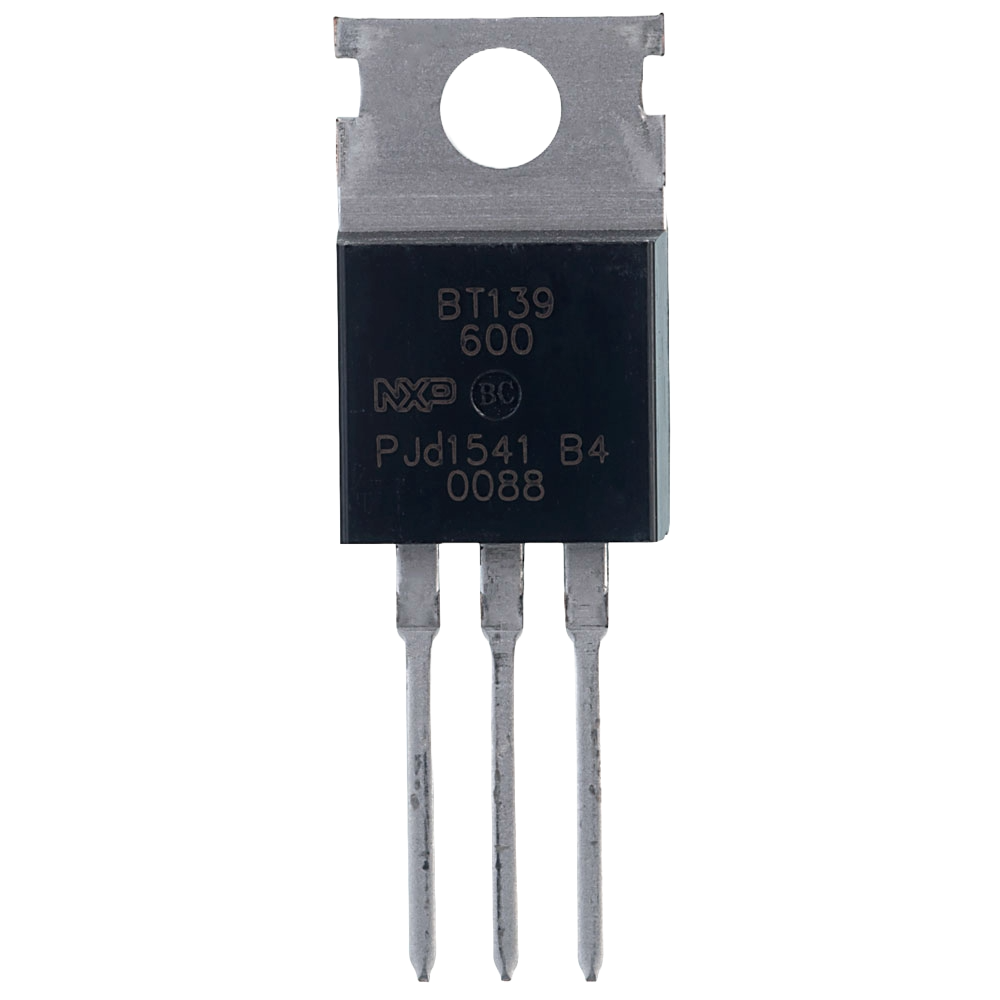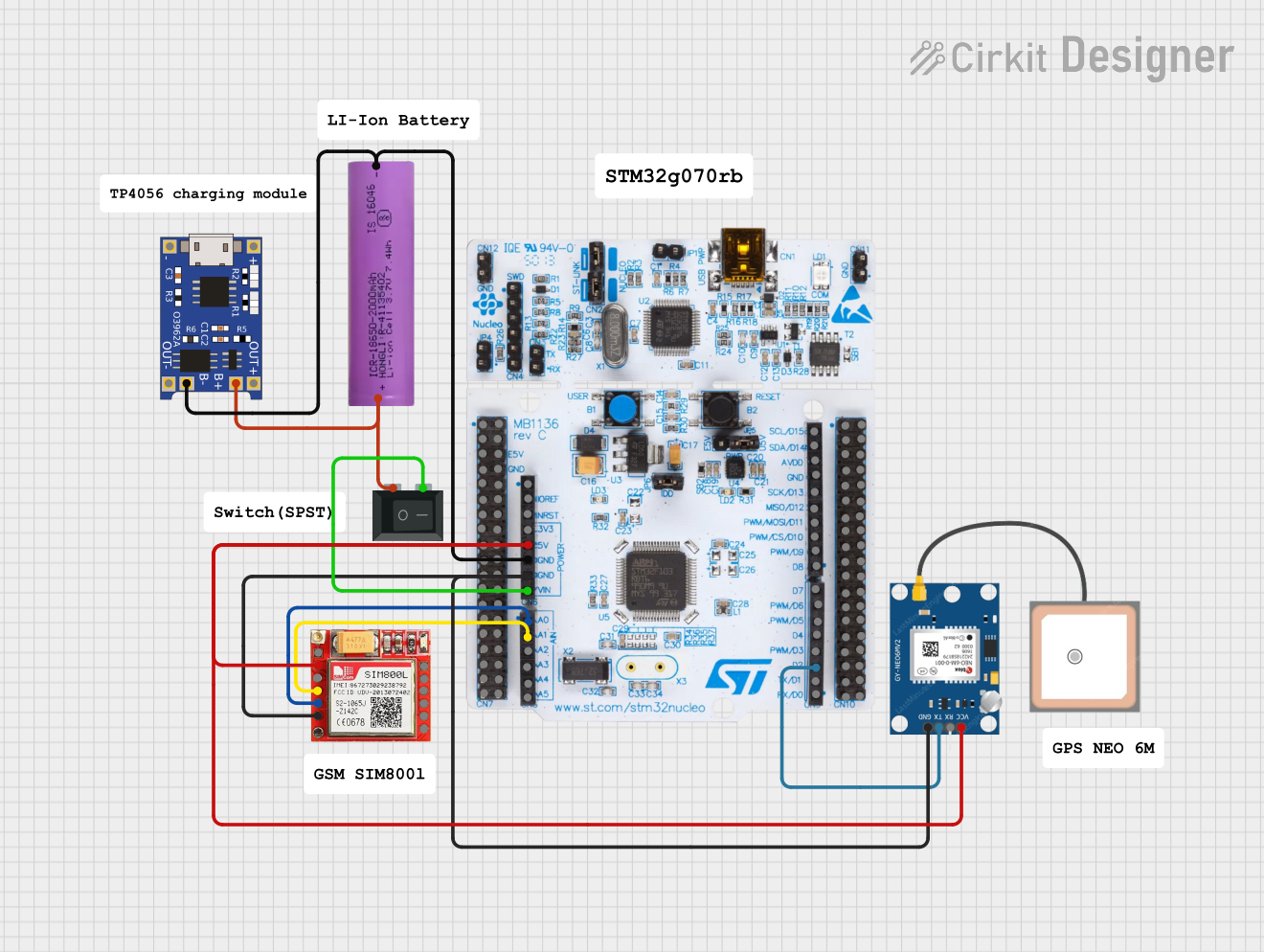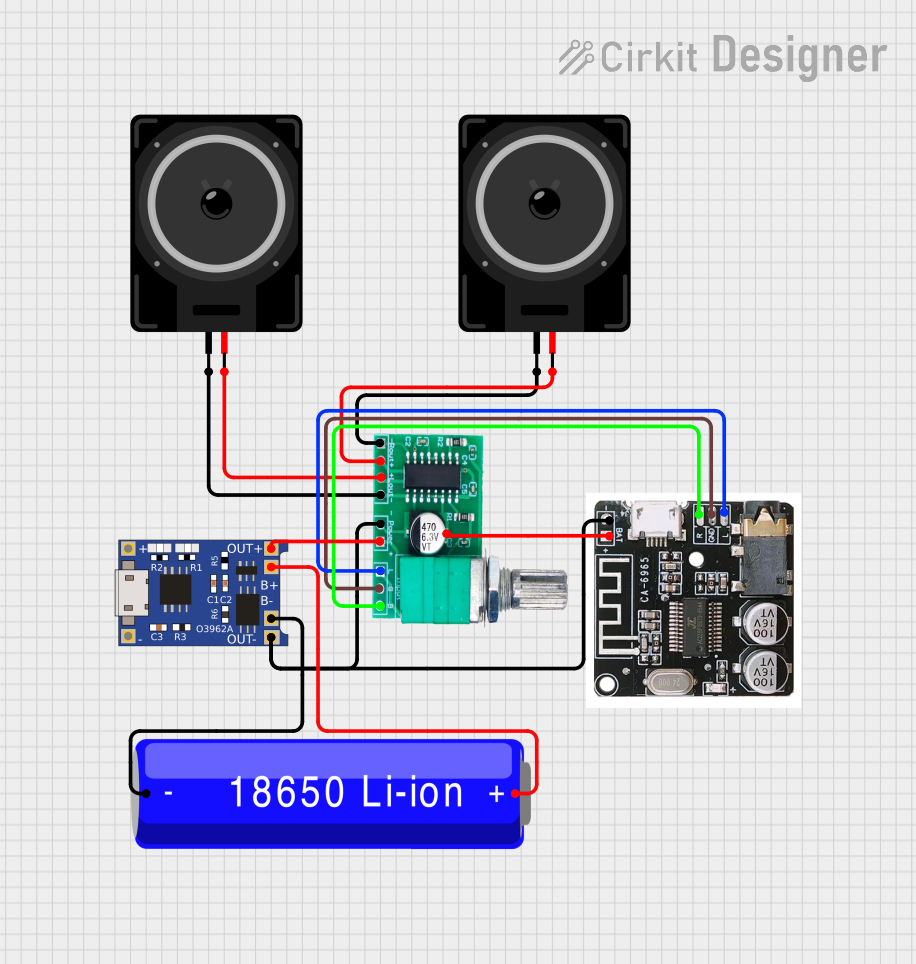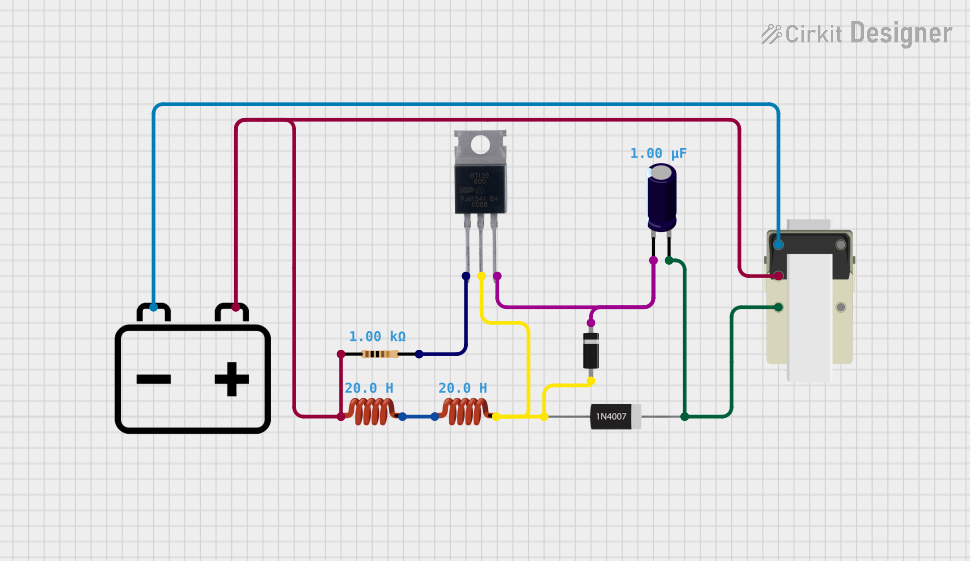
Cirkit Designer
Your all-in-one circuit design IDE
Home /
Component Documentation
How to Use BT136 600: Examples, Pinouts, and Specs

 Design with BT136 600 in Cirkit Designer
Design with BT136 600 in Cirkit DesignerIntroduction
The BT136 600 is a TRIAC (Triode for Alternating Current) designed for switching and phase control applications. It can handle a maximum voltage of 600V and is commonly used in light dimmers, motor speed controls, and other AC switching applications. This versatile component is ideal for controlling AC loads in various electronic projects.
Explore Projects Built with BT136 600
Battery-Powered Emergency Alert System with NUCLEO-F072RB, SIM800L, and GPS NEO 6M

This circuit is an emergency alert system that uses a NUCLEO-F072RB microcontroller to send SMS alerts and make calls via a SIM800L GSM module, while obtaining location data from a GPS NEO 6M module. The system is powered by a Li-ion battery and includes a TP4056 module for battery charging and protection, with a rocker switch to control power to the microcontroller.
 Open Project in Cirkit Designer
Open Project in Cirkit DesignerArduino Mega 2560 Based Security System with Fingerprint Authentication and SMS Alerts

This circuit features an Arduino Mega 2560 microcontroller interfaced with a SIM800L GSM module, two fingerprint scanners, an I2C LCD display, an IR sensor, and a piezo buzzer. Power management is handled by a PowerBoost 1000 Basic Pad USB, a TP4056 charging module, and a Li-ion 18650 battery, with an option to use a Mini AC-DC 110V-230V to 5V 700mA module for direct power supply. The primary functionality appears to be a security system with GSM communication capabilities, biometric access control, and visual/audible feedback.
 Open Project in Cirkit Designer
Open Project in Cirkit DesignerBluetooth Audio Receiver with Battery-Powered Amplifier and Loudspeakers

This circuit is a Bluetooth-enabled audio system powered by a rechargeable 18650 Li-ion battery. It includes a TP4056 module for battery charging and protection, a PAM8403 amplifier with volume control to drive two loudspeakers, and a Bluetooth audio receiver to wirelessly receive audio signals.
 Open Project in Cirkit Designer
Open Project in Cirkit DesignerVoltage Regulated Transformer Power Supply Circuit

This circuit appears to be a power supply circuit with a transformer connected to a 12V battery for voltage step-up or step-down. It includes a rectification stage with a 1N4007 diode, smoothing with an electrolytic capacitor, and regulation using a Zener diode. Additionally, there are inductors for filtering and a BT139 600 triac for controlling AC power, possibly for dimming or switching applications.
 Open Project in Cirkit Designer
Open Project in Cirkit DesignerExplore Projects Built with BT136 600

Battery-Powered Emergency Alert System with NUCLEO-F072RB, SIM800L, and GPS NEO 6M
This circuit is an emergency alert system that uses a NUCLEO-F072RB microcontroller to send SMS alerts and make calls via a SIM800L GSM module, while obtaining location data from a GPS NEO 6M module. The system is powered by a Li-ion battery and includes a TP4056 module for battery charging and protection, with a rocker switch to control power to the microcontroller.
 Open Project in Cirkit Designer
Open Project in Cirkit Designer
Arduino Mega 2560 Based Security System with Fingerprint Authentication and SMS Alerts
This circuit features an Arduino Mega 2560 microcontroller interfaced with a SIM800L GSM module, two fingerprint scanners, an I2C LCD display, an IR sensor, and a piezo buzzer. Power management is handled by a PowerBoost 1000 Basic Pad USB, a TP4056 charging module, and a Li-ion 18650 battery, with an option to use a Mini AC-DC 110V-230V to 5V 700mA module for direct power supply. The primary functionality appears to be a security system with GSM communication capabilities, biometric access control, and visual/audible feedback.
 Open Project in Cirkit Designer
Open Project in Cirkit Designer
Bluetooth Audio Receiver with Battery-Powered Amplifier and Loudspeakers
This circuit is a Bluetooth-enabled audio system powered by a rechargeable 18650 Li-ion battery. It includes a TP4056 module for battery charging and protection, a PAM8403 amplifier with volume control to drive two loudspeakers, and a Bluetooth audio receiver to wirelessly receive audio signals.
 Open Project in Cirkit Designer
Open Project in Cirkit Designer
Voltage Regulated Transformer Power Supply Circuit
This circuit appears to be a power supply circuit with a transformer connected to a 12V battery for voltage step-up or step-down. It includes a rectification stage with a 1N4007 diode, smoothing with an electrolytic capacitor, and regulation using a Zener diode. Additionally, there are inductors for filtering and a BT139 600 triac for controlling AC power, possibly for dimming or switching applications.
 Open Project in Cirkit Designer
Open Project in Cirkit DesignerTechnical Specifications
Key Technical Details
| Parameter | Value |
|---|---|
| Maximum Voltage | 600V |
| Maximum Current | 4A |
| Gate Trigger Current (I_GT) | 5mA |
| Holding Current (I_H) | 2mA |
| On-State Voltage Drop (V_TM) | 1.5V |
| Package Type | TO-220 |
Pin Configuration and Descriptions
| Pin Number | Pin Name | Description |
|---|---|---|
| 1 | MT1 | Main Terminal 1 |
| 2 | MT2 | Main Terminal 2 |
| 3 | Gate | Gate (triggering terminal) |
| Tab | MT2 | Main Terminal 2 (connected to the tab) |
Usage Instructions
How to Use the BT136 600 in a Circuit
- Identify the Pins: Ensure you correctly identify the MT1, MT2, and Gate pins.
- Connect MT2 to Load: Connect the MT2 pin to one end of the AC load.
- Connect MT1 to AC Source: Connect the MT1 pin to the AC source.
- Gate Triggering: Use a small current (typically 5mA) to trigger the Gate pin. This can be done using a microcontroller like an Arduino UNO.
Important Considerations and Best Practices
- Heat Dissipation: Ensure proper heat dissipation by using a heatsink if necessary, especially for high current applications.
- Isolation: Maintain electrical isolation between the control circuit and the AC load to prevent damage and ensure safety.
- Snubber Circuit: Use a snubber circuit (a resistor-capacitor network) across the TRIAC to protect against voltage spikes and ensure reliable operation.
Example Circuit with Arduino UNO
/*
* Example code to control a BT136 600 TRIAC using an Arduino UNO.
* This code will turn on an AC load connected to the TRIAC.
*/
const int gatePin = 9; // Pin connected to the Gate of the TRIAC
void setup() {
pinMode(gatePin, OUTPUT); // Set the gate pin as an output
}
void loop() {
digitalWrite(gatePin, HIGH); // Trigger the TRIAC
delay(1000); // Keep the load on for 1 second
digitalWrite(gatePin, LOW); // Turn off the TRIAC
delay(1000); // Keep the load off for 1 second
}
Troubleshooting and FAQs
Common Issues and Solutions
TRIAC Not Triggering:
- Solution: Ensure the Gate current is sufficient (at least 5mA). Check the connections and verify the control signal from the microcontroller.
Overheating:
- Solution: Use a heatsink to dissipate heat. Ensure the load current does not exceed the maximum rating of 4A.
Unstable Operation:
- Solution: Implement a snubber circuit across the TRIAC to protect against voltage spikes and ensure stable operation.
FAQs
Q1: Can I use the BT136 600 for DC applications?
- A1: No, the BT136 600 is designed for AC applications only. For DC switching, consider using a MOSFET or a relay.
Q2: What is the purpose of the snubber circuit?
- A2: A snubber circuit protects the TRIAC from voltage spikes and ensures reliable operation by preventing false triggering.
Q3: How do I calculate the required heatsink size?
- A3: The required heatsink size depends on the power dissipation and ambient temperature. Use the thermal resistance (junction-to-ambient) and power dissipation to calculate the heatsink's thermal resistance.
By following this documentation, you should be able to effectively use the BT136 600 TRIAC in your AC switching and phase control applications.